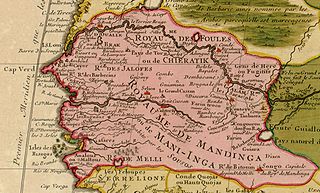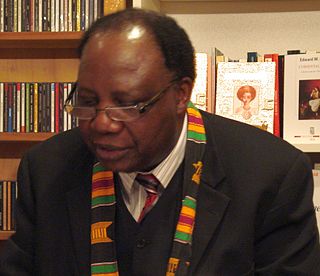A cimpaba (sometimes tshimphaaba or chimpaba) is a sword from the Woyo of the Democratic Republic of Congo.
Contents

A cimpaba (sometimes tshimphaaba or chimpaba) is a sword from the Woyo of the Democratic Republic of Congo.

It is a Woyo dignitary's symbol. [1] It is part of the attributes of power of the Mangoyo (the king). [2] Its shape is very special and cannot be confused with any other type of African knives or swords, the handle is often made of ivory. The cimpaba is also used among the Kakongo and the Vili [3] in the Muanda region, in the lower Congo. [4]

The history of Senegal is commonly divided into a number of periods, encompassing the prehistoric era, the precolonial period, colonialism, and the contemporary era.

Biffeche or Bifeche is an area of Senegal centred on the town of Savoigne, around 30 kilometres north-east of the major coastal city of Saint-Louis.

The Kongo people are a Bantu ethnic group primarily defined as the speakers of Kikongo. Subgroups include the Beembe, Bwende, Vili, Sundi, Yombe, Dondo, Lari, and others.

Pool is a department of the Republic of the Congo in the southeastern part of the country. It borders the departments of Bouenza, Lékoumou, and Plateaux. Internationally, it borders the Democratic Republic of the Congo. It also surrounds the commune district of the national capital, Brazzaville.

Ngoyo was an Iron Age kingdom state of the Woyo ethnic group, located in the south of Cabinda. Located on the Atlantic coast of Central Africa, just north of the Congo River, it was founded by Bantu-speaking people around the 15th century. Ngoyo tradition held that the kingdom's ancestors were among the earliest settlers in the area, leading their chiefs to title themselves the nfumu nsi. The capital was Mbanza Ngoyo. By 1700, Cabinda had become the leading slave port north of Luanda, and Ngoyo's economy rested heavily on the sale of slaves.

Théophile Obenga is professor emeritus in the Africana Studies Center at San Francisco State University. He is a politically active proponent of Pan-Africanism and an Afrocentrist. Obenga is an Egyptologist, linguist, and historian.

Senegalese wrestling is a type of folk wrestling traditionally performed by the Serer people and now a national sport in Senegal and parts of The Gambia, and is part of a larger West African form of traditional wrestling. The Senegalese form traditionally allows blows with the hands (frappe), the only one of the West African traditions to do so. As a larger confederation and championship around Lutte Traditionnelle has developed since the 1990s, Senegalese fighters now practice both forms, called officially Lutte Traditionnelle sans frappe and Lutte Traditionnelle avec frappe for the striking version.
The Kingdom of Sine was a post-classical Serer kingdom along the north bank of the Saloum River delta in modern Senegal. The inhabitants are called Siin-Siin or Sine-Sine.

The medieval history of the Serer people of Senegambia is partly characterised by resisting Islamization from perhaps the 11th century during the Almoravid movement, to the 19th century Marabout movement of Senegambia and continuation of the old Serer paternal dynasties.

Christian-Joseph Guyonvarc'h was a Breton philologist and linguist who specialised in Celtic studies.
Roog or Rog is the Supreme God and creator of the Serer religion of the Senegambia region.
Pangool singular: Fangool, are the ancient saints and ancestral spirits of the Serer people of Senegal, the Gambia and Mauritania. The Pangool play a crucial role in Serer religion and history. In a religious sense, they act as interceders between the living world and the supreme being Roog or Koox. In a historical sense, the ancient Serer village and town founders called Lamanes were believed to be accompanied by a group of Pangool as they travelled in search of land to exploit. These Lamanes became guardians of Serer religion and created shrines in honour of the Pangool, thus becoming the custodians of the "Pangool cult".
Maad a Sinig Maysa Wali Jaxateh Manneh was a king described in the oral tradition of the Serer pre-colonial Kingdom of Sine and the first of the Guelowar maternal dynasty to rule in Serer country. He reigned as Maad a Sinig from c. 1350 to 1370.
The Royal House of Boureh Gnilane Joof was a royal house founded in the 14th century by Jaraff Boureh Gnilane Joof. He was a member the Serer tribe, from the pre-colonial Kingdom of Sine now part of independent Senegal. It was the first royal house founded by the Joof family during the Guelowar period. Boureh Gnilane Joof was a royal prince and a Jaraff, a Serer title of nobility with the powers of a prime minister. He was neither a Maad a Sinig nor a Maad Saloum but a royal prince who had the title Jaraff bestowed upon him by his cousin and brother-in-law - Maad a Sinig Diessanou Faye. His father Maad Patar Kholleh Joof was the king of Laa and Teigne of Baol. Boureh's brothers were the first from this house to have succeeded to the throne of Sine during the Guelowar period. His name was adopted in his honour to refer to the first royal house founded by the Joof family during this dynastic period. The Joof family of Sine, from this royal house also ruled in the Kingdom of Saloum The Joof family also ruled in Baol. From the date of its foundation up to the abolition of the Serer monarchies of Sine and Saloum in 1969, at least ten kings from this house had succeeded to the throne of Sine. As the first royal house of Sine founded by the Joof family in this dynastic period, the Royal House of Boureh Gnilane Joof holds great significance in Senegambian, Joof family and Serer history, because all the subsequent royal houses founded by the Joof family branched out from this royal house.

The Joos Maternal Dynasty was a Serer maternal dynasty which originated from the Serer pre-colonial Kingdom of Sine in the 14th century and spread to the Wolof Kingdom of Waalo. The matriarch or founder of this maternal dynasty was Lingeer Fatim Beye, a princess and queen originally from the Kingdom of Sine. In Waalo, it was founded by the princess Lingeer Ndoye Demba of Sine. Lingeer Ndoye Demba was the maternal granddaughter of Lingeer Fatim Beye. They both came from the Serer ethnic group. Although the pre-colonial Kingdoms of Sine and Waalo now form part of modern-day Senegal, in pre-colonial Senegambia, present-day Gambia had open-borders with Senegal and share the same historical and cultural heritage. The demarcation of the two countries is purely geographical due to their colonial past, with Britain colonizing the Gambia and France colonizing Senegal. For a background to these events see the History of Senegal, History of the Gambia, Senegambia and Timeline of Serer history.
Raymond Isaac Follo is a Congolese politician who has served in the National Assembly of Congo-Brazzaville since 2012.

Franck Mwe di Malila, was a Congolese politician and adviser to the former Senate president of the Democratic Republic of the Congo, Léon Kengo Wa Dondo. As of Mai 2019 he was serving as intérim vice-Prime Minister and deputy Minister for Foreign Affairs. He previously served as Deputy Minister of International Relations and National Integration as well as Deputy Minister of Planning and as Minister of Tourism.

Édouard Lendje Héritier Mwe di Malila Apenela was a Congolese businessman, founder and president of the Woyo Alliance, former president and donator of the football club AS Dragons.

Jonathan Mwe di Malila also known as Jonathan Malila, is a congolese-born artist living and working in Cologne, Germany. His artwork tries to thematizise congolese everyday Culture, which he dubbed Congo Pop. He is a nephew of the congolese deputy minister of international relation and national integration Franck Mwe di Malila and is also a descendant of the Mwe di Malila family, among the most notable families in Kinshasa, Cabinda and Bas-Congo. Mwe di, an honorable particule meaning Lord, derives from the Kikongo term Mwene, the title of the Lords and Nobility of the Kingdom of Kongo.

Edmond van Eetvelde was a Belgian diplomat and first General Administrator of the Department of Foreign Affairs of the Congo Free State. He is also famous for commissioning the Belgian Art Nouveau architect Victor Horta in 1898 to build the Hôtel van Eetvelde, his private residence in Brussels.